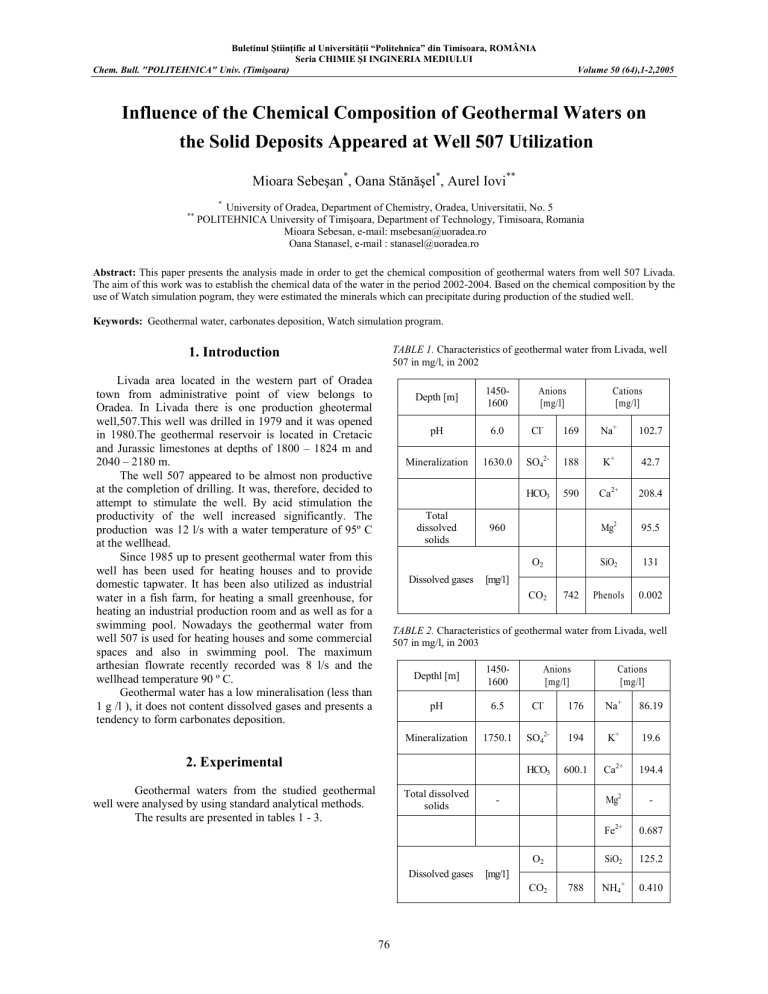Document 13359583

Buletinul Ş tiin ţ ific al Universit ăţ ii “Politehnica” din Timisoara, ROMÂNIA
Seria CHIMIE Ş I INGINERIA MEDIULUI
Chem. Bull. "POLITEHNICA" Univ. (Timi ş oara) Volume 50 (64),1-2,2005
Influence of the Chemical Composition of Geothermal Waters on
the Solid Deposits Appeared at Well 507 Utilization
Mioara Sebe
ş
an
*
, Oana St
ă
n
ăş
el
*
, Aurel Iovi
**
* University of Oradea, Department of Chemistry, Oradea, Universitatii, No. 5
** POLITEHNICA University of Timi ş oara, Department of Technology, Timisoara, Romania
Mioara Sebesan, e-mail: msebesan@uoradea.ro
Oana Stanasel, e-mail : stanasel@uoradea.ro
Abstract: This paper presents the analysis made in order to get the chemical composition of geothermal waters from well 507 Livada.
The aim of this work was to establish the chemical data of the water in the period 2002-2004. Based on the chemical composition by the use of Watch simulation pogram, they were estimated the minerals which can precipitate during production of the studied well.
Keywords: Geothermal water, carbonates deposition, Watch simulation program.
1. Introduction
Livada area located in the western part of Oradea town from administrative point of view belongs to
Oradea. In Livada there is one production gheotermal well,507.This well was drilled in 1979 and it was opened in 1980.The geothermal reservoir is located in Cretacic and Jurassic limestones at depths of 1800 – 1824 m and
2040 – 2180 m.
The well 507 appeared to be almost non productive at the completion of drilling. It was, therefore, decided to attempt to stimulate the well. By acid stimulation the productivity of the well increased significantly. The production was 12 l/s with a water temperature of 95º C at the wellhead.
Since 1985 up to present geothermal water from this well has been used for heating houses and to provide domestic tapwater. It has been also utilized as industrial water in a fish farm, for heating a small greenhouse, for heating an industrial production room and as well as for a swimming pool. Nowadays the geothermal water from well 507 is used for heating houses and some commercial spaces and also in swimming pool. The maximum arthesian flowrate recently recorded was 8 l/s and the wellhead temperature 90 º C.
Geothermal water has a low mineralisation (less than
1 g /l ), it does not content dissolved gases and presents a tendency to form carbonates deposition.
TABLE 1. Characteristics of geothermal water from Livada, well
507 in mg/l, in 2002
Depth [m]
Mineralization 1630.0 SO
4
2-
Total dissolved solids
Dissolved gases [mg/1]
TABLE 2. Characteristics of geothermal water from Livada, well
507 in mg/l, in 2003
Depthl [m]
1450-
1600
960
1450-
1600
Anions
[mg/l]
HCO
3
O
2
CO
2
Mineralization 1750.1 SO
4
2-
169
188
Na + 102.7
590 Ca 2+ 208.4
Mg 2
SiO
2
Na + 86.19
K +
42.7
95.5
131
742 Phenols 0.002
Anions
[mg/l]
176
194
Cations
[mg/l]
K +
Cations
[mg/l]
19.6
2. Experimental
Geothermal waters from the studied geothermal well were analysed by using standard analytical methods.
The results are presented in tables 1 - 3.
Total dissolved solids
-
Dissolved gases [mg/1]
HCO
3
O
2
CO
2
600.1 Ca 2+ 194.4
Mg 2
Fe 2+
SiO
2
125.2
788 NH
4
+
-
0.687
0.410
76
Chem. Bull. "POLITEHNICA" Univ. (Timi ş oara) Volume 50 (64),1-2,2005
TABLE 3. Characteristics of geothermal water from Livada, well
507 in mg/l, in 2004
Depth [m]
1450-
1600
Anions
[mg/l]
Cations
[mg/l]
175.15 Na + 97.1
TABLE 4. Values of log. solubility products of minerals in deep water at different temperatures in 2002
Log Q/K
Temperature, °C
90 75 60 45 30
Mineralization 1801.0 SO
4
2- 208 K + 39.2 Anhydrite -0.212 -0.629 -0.741 -0.848 -0.950
HCO
3
610 Ca 2+ 114
Total dissolved solids
1008 Mg 2 98.76
Chalcedony
-0.026 0.390 0.533 0.689 0.860
Fe 2+ 0.020
Wollastonite
-3.345 -5.124 -5.658 -6.205 -6.765
O
2
SiO
2
120
Dissolved gases [mg/1]
CO
2
815 Phenols 0.004
Chrysotile 0.890 -4.016 -5.469 -6.952 -8.461
3. Results and discussion
The results of the laboratory analyses have been calculated in the Watch simulation program at production temperature and by cooling in steps of 15º C.
In this way it is possible to predict the scaling potential. By the use of the program it was calculated the ionic activity Q corresponding to different minerals in the brine and it was compared with the theoretical solubility,
K, of the respective minerals. When Q < K the saturation index is negative and the solution is undersaturated with respect to the mineral considered.
When Q >K the solution is supersaturated and when
Q = K the solution is exactly saturated or in equilibrium with the mineral in respect.
Changes in water by cooling within the system during utilization can by modelled and subsequent changes in chemistry evaluated. This is an important tool for the assessment of scaling problems.
The results obtained by the Watch program are presented in figures 1 – 3.
Amorph. silica
4
2
0
-2
-4
-6
-8
-10
0
-0.580 -0.304 -0.209 -0.106 0.008
50
Tem perature, C
100
Livada 507,2002 anhydrite calcite chalcedony quartz wollastonite talc chrysotile amorphons silica
Figure 1.
Log.Q/K vs temperature for selected water from well 507
Livada in 2002.
77
Chem. Bull. "POLITEHNICA" Univ. (Timi ş oara) Volume 50 (64),1-2,2005
TABLE 5 . Values of log. solubility products of minerals in deep water at different temperatures in 2003.
Log Q/K
Temperature, °C
92 75 60 45 30
TABLE 6. Values of log. solubility products of minerals in deep water at different temperatures in 2004.
Log Q/K
Temperature. °C
89 75 60 45 30
Anhydrite -0.529 -0.851 -0.954 -1.055 -1.152
Anhydrite -0.022 -0.482 -0.616 -0.744 -0.865
Calcite 1.243 0.568 0.381 0.206 0.047
Chalcedony
-0.025 0.370 0.513 0.669 0.841
Quartz 0.199 0.670 0.835 1.009 1.191
Chalcedony
Wollastonite
-0.024 0.351 0.495 0.651 0.822
-2.864 -4.440 -4.973 -5.518 -6.077
Wollastonite
Amorph. silica
-2.569 -4.202 -4.726 -5.264 -5.816
-0.587 -0.324 -0.229 -0.126 -0.011
LIVADA 507, 2003
Chrysotile 3.434 -1.049 -2.524 -4.022 -5.540
Amorph.
Silica
-0.592 -0.343 -0.247 -0.144 -0.030
LIVADA 507, 2004
2 anhydrite
8
1
0
-1
-2
-3
-4 calcite chalcedony quartz wollastonite amorphons silica
6
4
2
0
-2 anhydrite calcite chalcedony quartz wollastonite talc chrysotile amorphons silica
-5 -4
-6
-6
-7
0 20 40 60
T emperature, C
80 100
Figure 2.
Log.Q/K vs temperature for selected water from well 507
Livada in 2003.
-8
0 50
Temperature, C
100
Figure 3.
Log.Q/K vs temperature for selected water from well 507
Livada in 2004.
78
Chem. Bull. "POLITEHNICA" Univ. (Timi ş oara) Volume 50 (64),1-2,2005
The saturation indexes were calculated for the following minerals: calcite, chalcedony, quartz, talc, chrysotile, amorphus silica.
4.Conclusions
Major problems have arisen in heating services due to mineral depositions.
The potential scaling problems of a geothermal utilization depend on the type of water.
Therefore chemical analysis of geothermal water from well 507 from Livada were made in order to predict possible scaling. A simulation program was used to estimate the depositions which can be formed at different temperatures reached during geothermal water utilization.
It is better to avoid scales before they occur.
In case of mineral depositions inside the pipes a mechanical removal is not convenient. Geothermal waters with a scaling tendency must be treated by chemical method in order to prevent the deposits. It is recommended to inject chemical inhibitors into the well.
References
1. Cineti, A., Resursele de ape subterane ale României,
Ed.Tehnic
ă , Bucure ş ti, 1990.
2. Demetrescu, A.M. ş .a., Analiza tehnic ă a minereurilor,
Ed.Tehnic
ă , Bucure ş ti, 1966.
3. Franco, D., Olafsson, M., Fluid sampling for geothermal prospecting, Roma, 1991.
4. P ă troescu, C., G ă nescu, I., Analiza apelor, Ed. Scrisul
Românesc, Craiova, 1980.
5. Tarquini, B., Scaling problems of use of geothermal waters, International Workshop on Products &
Technologies for Low Temperature Geothermal
Industry, Oradea, 1994.
6. Trujillo, P. E., et. al., Chemical Analysis and Sampling
Techniques for Geothermal Fluids and Gases at the Fenton
Hill Laboratory, Los Alamos National Laboratory, New
Mexico, report LA-11006-MS, 1987.
7. Babko, A.K., Pilipenko, A.T., Photometric Analysis.
Methods of determining nonmetals, Mir Publisher,
Moscow, 1974.
79








